With farmers struggling to contain the fast-spreading infectious Lumpy Skin Disease that has affected an estimated 19,000 cattle in the state, dairy unions fear that milk shortage could disrupt market and hit consumers like you hard
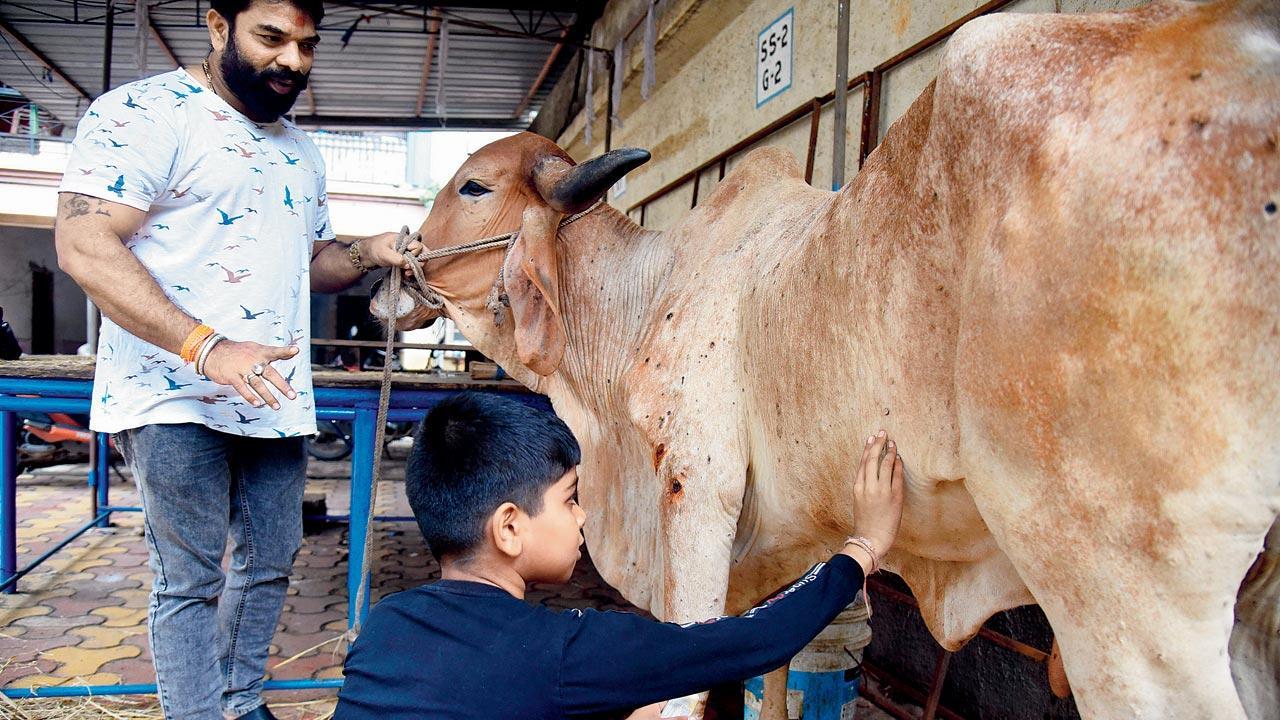
Dairy farmer Prasad Patil, a resident of Mansarovar in Bhiwandi, has moved his cow Gauri from the farm shelter and is currently looking after her in the compound of his residential society. His son Meet Manoj Patil, 12, helps look after the cow after school, applying ointment on her skin nodules. Pic/Sameer Markande
Dairy farmer Dnyaneshwar Patil is in a tizzy when we meet him on a weekday afternoon at his cow shelter in Shelar village, Bhiwandi. This writer and mid-day photographer Sameer Markande travelled nearly 50 km from Mumbai city, to find themselves walking straight into a medical emergency. Moments ago, veterinarians from the animal husbandry department of the district, Dr Ajit Hirve and Dr Ali Asghar, had arrived.
ADVERTISEMENT
Everyone is waiting for Yashoda to appear. She is Patil’s six-year-old cow who has begun to show skin infection symptoms including nodules on her body, which Patil alerted the authorities about. She has gone out grazing with the other cattle, and is expected any moment. When finally at 12.30 pm, Yashoda ambles into the shelter, her pace is slow. She has also developed high grade fever and seems to be in discomfort.
“This is Lumpy!” announces one of the veterinarians, who recognised the node-like growths on her skin as the chief symptom of Lumpy Skin Disease (LSD). Yashoda is tied at one end of the shelter to isolate her from other cattle and limit spread of the infection. Dr Ajit Hirve, assistant commissioner in the animal husbandry department in Bhiwandi, puts a thermometer in the animal’s anus to check the temperature. After confirming the diagnosis, he fills in three large syringes with antibiotics and pain relievers and injects her.
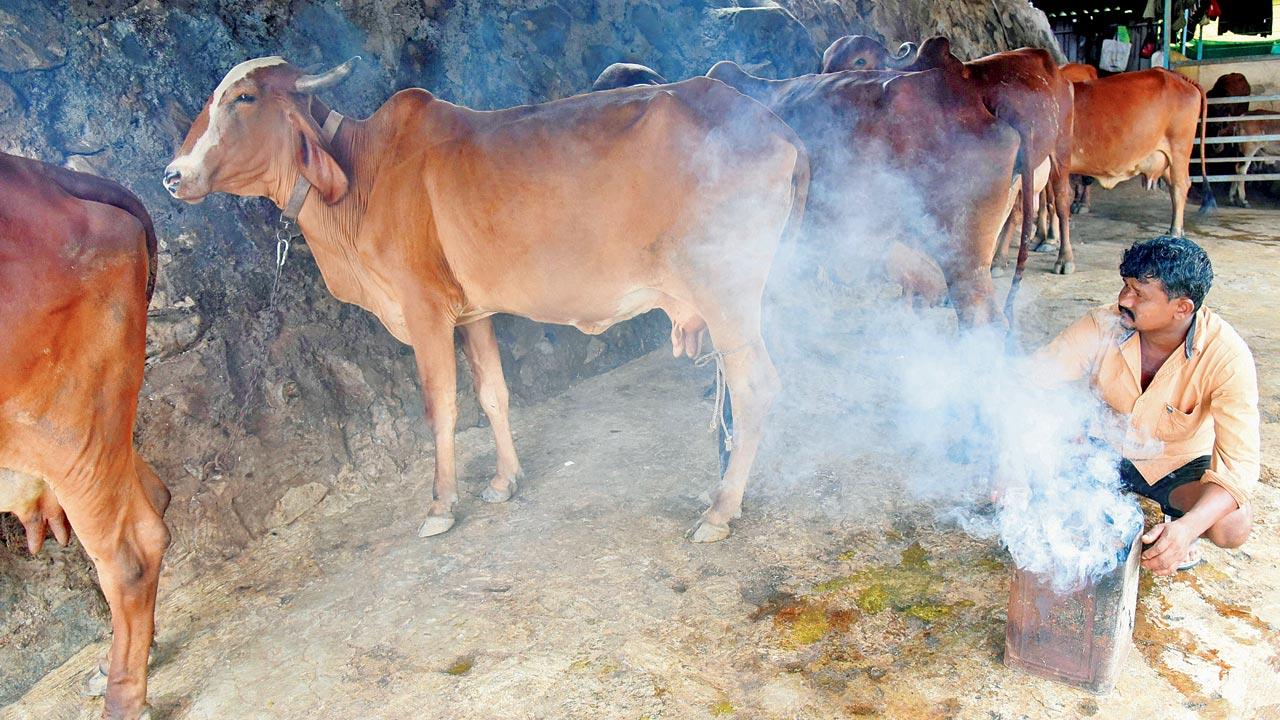 Six-year-old Yashoda from Shelar village in Bhiwandi got infected with Lumpy Skin Disease (LSD) last week, despite being vaccinated with the goat pox vaccine. High grade fever, loss of appetite, congestion and skin nodules has left the animal in extreme pain. She has also lost the capacity to produce milk due to fever. Vets from the animal husbandry department are treating her symptomatically with antibiotics and pain relievers. Pics/Sameer Markande
Six-year-old Yashoda from Shelar village in Bhiwandi got infected with Lumpy Skin Disease (LSD) last week, despite being vaccinated with the goat pox vaccine. High grade fever, loss of appetite, congestion and skin nodules has left the animal in extreme pain. She has also lost the capacity to produce milk due to fever. Vets from the animal husbandry department are treating her symptomatically with antibiotics and pain relievers. Pics/Sameer Markande
Yashoda is one of an estimated 19,160 cattle across 30 out of the total 36 districts in Maharashtra infected with LSD. The approximate deaths in the state stand at 600; the number saw a jump in the last week. The national numbers, as of September 21, stand at close to 18.5 lakh, according to Union Minister of Animal Husbandry Sanjeev Balyan. So far, over 60,000 deaths have been reported pan-India.
According to the Food and Agriculture Organisation (FAO) of the United Nations, LSD is a viral vector-borne contagious pox disease seen in domestic cattle and the Asian water buffalo. The clinical features of the disease, as per a study published by researchers from the School of Veterinary Medicine, Shiraz University, Iran, include “fever, inappetence, nasal discharge, salivation and lachrymation, enlarged lymph nodes, loss of body weight and sometimes death”.
“She didn’t even come in contact with any other infected animal,” says a perplexed Patil wondering how Yashoda caught the infection. Just a few weeks ago, when news of the disease made another round of headlines, Patil had vaccinated all his cattle with the goat pox vaccine, including Yashoda.
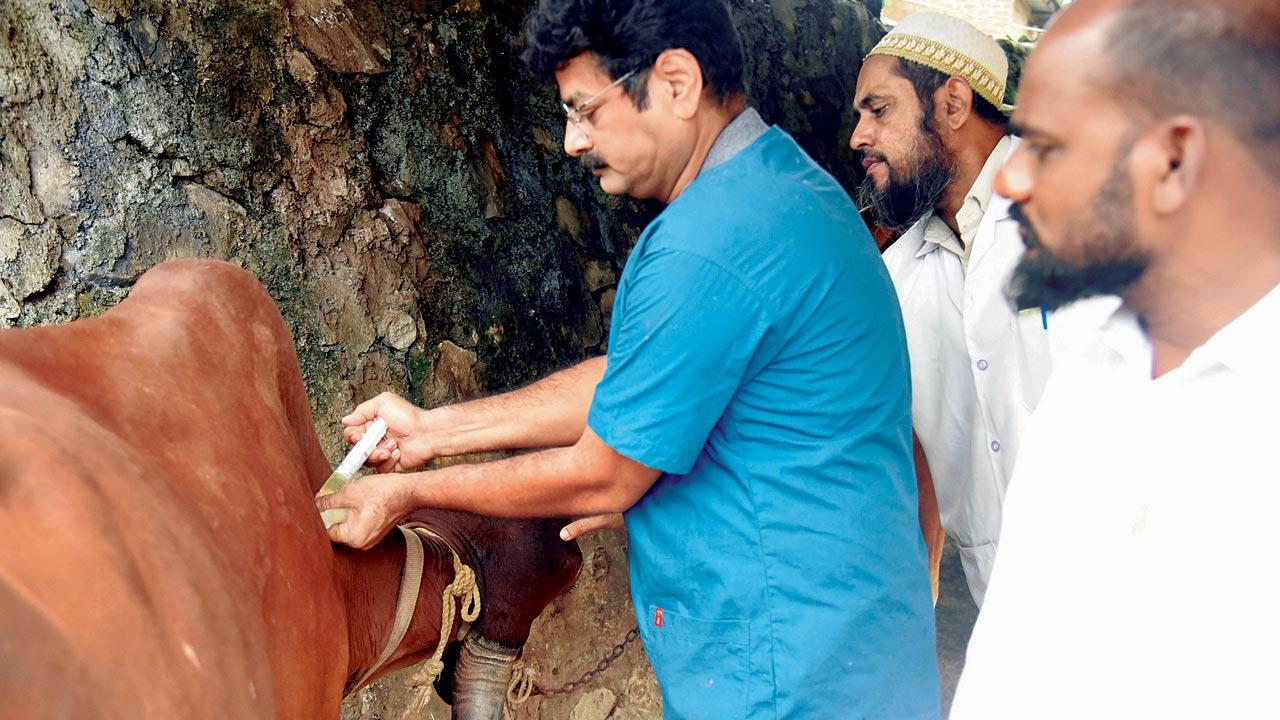
Dr Hirve suspects that Yashoda may have picked up the infection prior to being vaccinated. “The incubation period [the time between the actual infection and appearance of the first symptoms] of LSD, is about 28 to 30 days. It’s likely that Yashoda got infected a while ago.”
In India, the first case of LSD was reported on April 23 this year in Kutch, Gujarat. Since then, it has spread across states and union territories, including Madhya Pradesh, Punjab, Uttarakhand, Uttar Pradesh, Jammu & Kashmir, with some of the highest numbers being reported in Rajasthan. Chief Minister Ashok Gehlot has written to the Centre after more than 20,000 cows died of the disease. Gehlot demanded that the government declare LSD a pandemic in cows, especially in the absence of a vaccine specifically for Lumpy. News reports have highlighted the inability of states to handle large number of infections, with farmers abandoning infected cattle from fear, and carcasses lying in the open.
Dr Ali Asghar, livestock development officer at the animal husbandry department of Bhiwandi, says that in Maharashtra, the infection is no longer spreading from animals coming in from Gujarat or neighbouring affected areas, as was previously reported. “It [the transport of cattle] had been stopped by the government on a priority basis.”
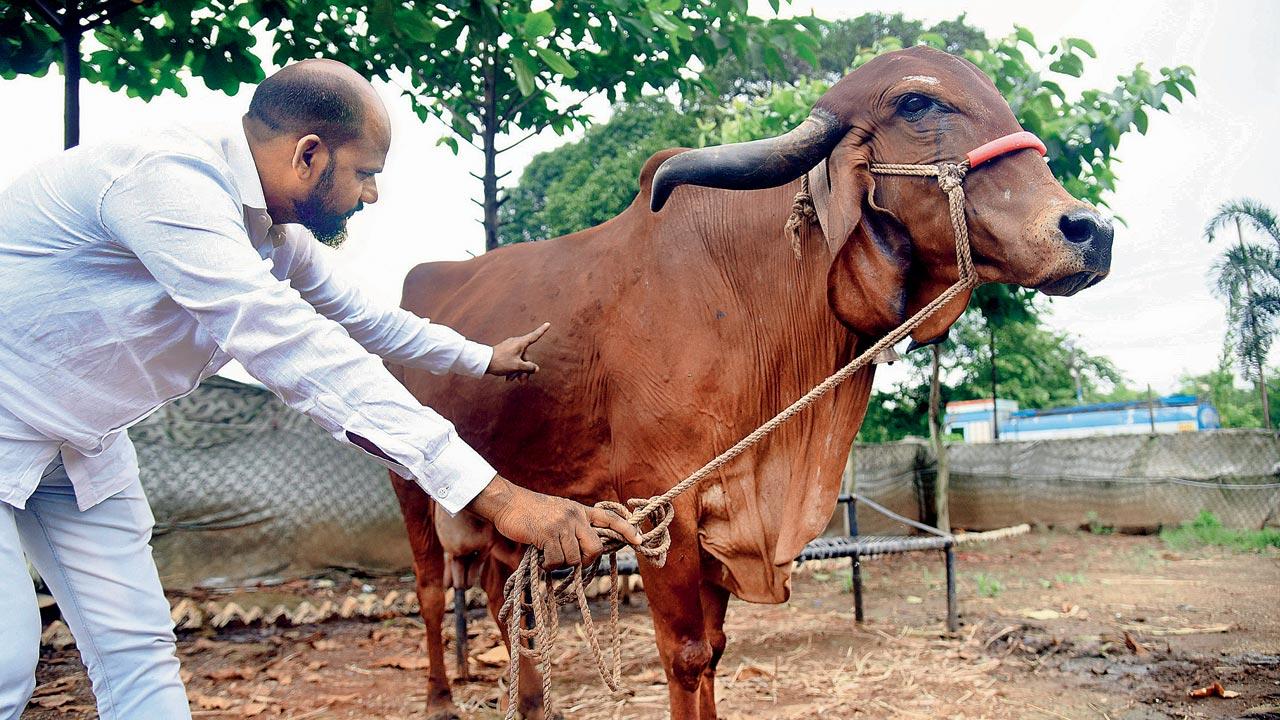
According to Dr Hirve, the virus is now spreading “through the bites of mosquitoes, and ticks and flies that sit on infected areas or animals, and then contaminate other cattle”. “Since it is the monsoon season, rainfall and high humidity provide adequate environment for these vectors to breed and grow. Cattle graze in grass, which has grown exponentially in this season and is host to various types of vectors carrying the virus. All of these have turned into localised reasons for the spread of the disease,” he explains.
FAO has said that transmission may also occur through consumption of contaminated feed or water by animals, natural mating and artificial insemination. While there is no treatment for LSD and a specific vaccine for the disease is yet to be available, symptomatic treatment and prevention techniques to keep secondary infections away, is the only way forward.
Since the disease is caused by the LSD virus (LSDV), a member of the genus Capripoxvirus (CaPV) that shares the genus with sheep pox virus (SPPV) and goat pox virus (GTPV), the cattle in India are at present being administered the sheep pox and goat pox vaccine. This however, offers just 60-70 per cent protection against LSD.
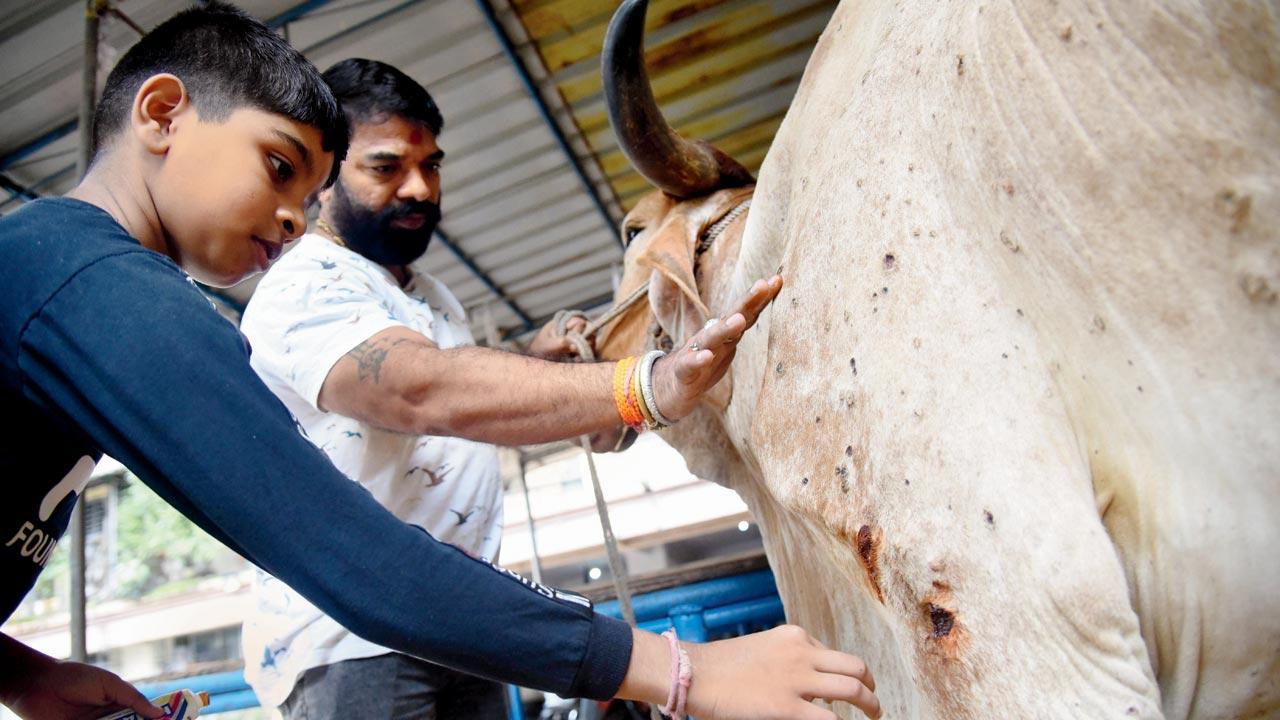 Gauri contracted LSD on August 28. Her owner Prasad Patil of Bhiwandi, has segregated her from other cattle on his farm, to the compound of his residential society where his children help him tend to the infection. Pic/Sameer Markande
Gauri contracted LSD on August 28. Her owner Prasad Patil of Bhiwandi, has segregated her from other cattle on his farm, to the compound of his residential society where his children help him tend to the infection. Pic/Sameer Markande
As of September 22, the Brihanmumbai Municipal Corporation (BMC) had vaccinated 2,203 of the 3,226 cows in Mumbai.
Recently, the Indian Council of Medical Research (ICMR) developed an indigenous vaccine for LSD called Lumpi-ProVacInd, but it is yet to be commercially available.
The FAO states that “Lumpy Skin Disease does not affect humans”. Scientist and veterinarian at ICMR’s NIRRCH Mumbai, Dr Uddhav Chaudhari, explains why: “This virus is host specific and that is cattle—both male and female, and rarely in buffalo in this case. It cannot spread to humans.” When asked about genetic mutations by virus, Dr Chaudhari says, “LSDV is a DNA virus, which does not change its genetic nature frequently like RNA virus, as was seen in the case of the novel Coronavirus. While humans are safe, it can spread within the same species of cattle. It can also infect a foetus of an affected female cow or can lead to miscarriage.” According to FAO, “infected pregnant cows are known to deliver calves with skin lesions. The virus may be transmitted to suckling calves through infected milk or from skin lesions in the teats”.
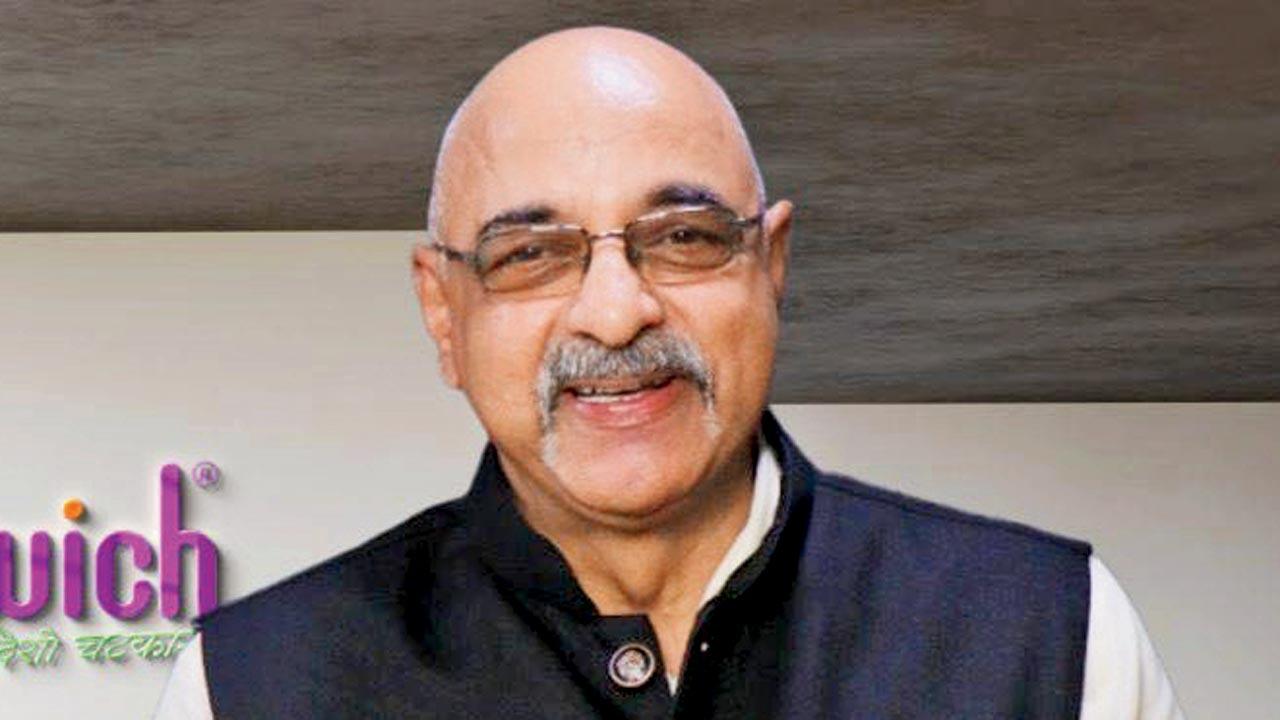 Dr Rajendra Kokane, retired professor, Bombay Veterinary College
Dr Rajendra Kokane, retired professor, Bombay Veterinary College
Irrespective, experts are suggesting exercising caution like maintaining hygiene, cutting off any unnecessary interaction with cattle and not touching the
affected areas.
For locals in Bhiwandi, the cow is sacred. The dairy farmers that mid-day met in the nearby villages are of the belief that “gau mata won’t infect or harm us”. Prasad Patil, resident of Mansarovar in Bhiwandi, which is about six km from Shelar, has moved his four-year-old cow Gauri from the farm shelter and is currently looking after her in the compound of his residential society. Her symptoms, he says, first appeared on August 28. “She got large boils on her skin. She was burning with fever and had accumulated congestion that weighed almost 10 kg. So, I segregated her from the rest of the cows on the farm and brought her to the society compound. Government vets started her treatment and she is much better now.”
Patil has been bathing Gauri with neem water and applying home-made oil to keep the flies away.
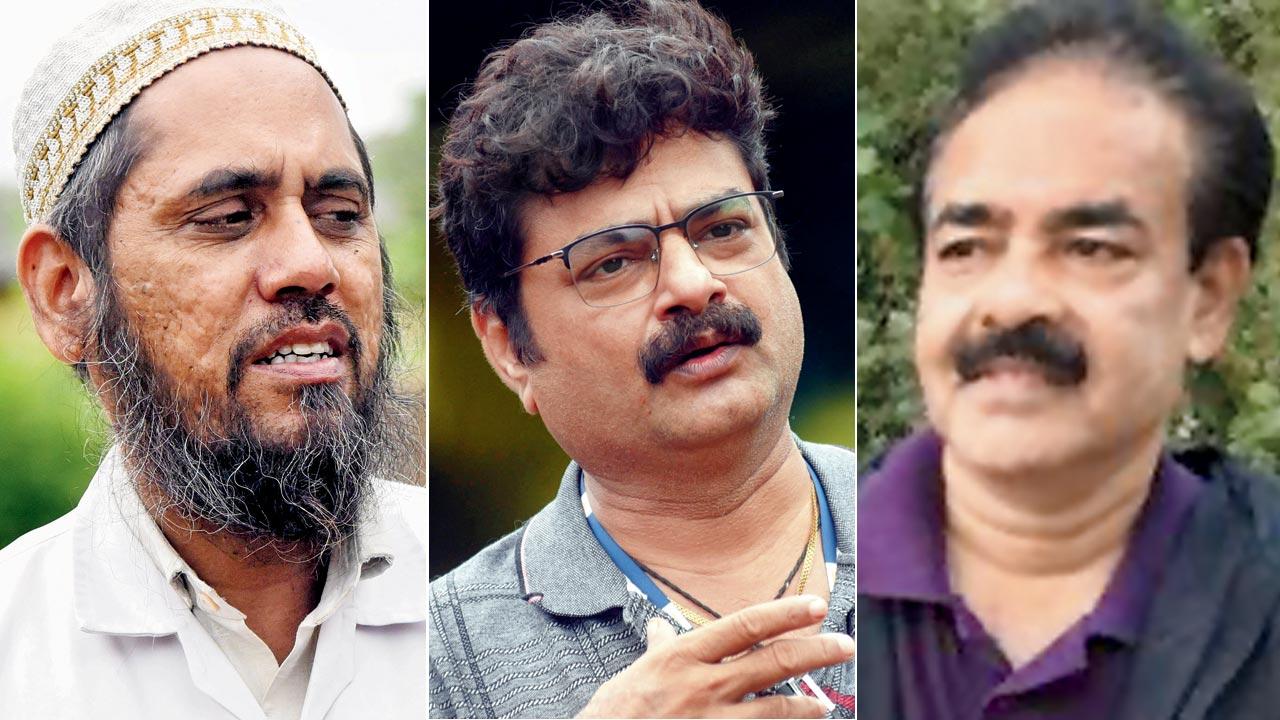 Dr Ali Asghar, Dr Ajit Hirve and Kiran L Dhavale
Dr Ali Asghar, Dr Ajit Hirve and Kiran L Dhavale
His 12-year-old son Meet Manoj Patil joins his father in caring for Gauri. “I take care of her after coming back from school. Sometimes, my friends from the
building also join. We apply ointment on her lumps and give her energy drinks, which my father makes for her, to build her immunity to fight off
the disease.”
Despite the care, Gauri has stopped producing milk since she got infected. “As an Indian Gir cow, she used to give about five to six litres of milk every day,” says Patil. At Badhwadh village, Gajendra Gulvi is also facing the same problem. His five-year-old Jersey cow used to produce 16 litres of milk daily when she was well. Now, a section of her udder is infected with skin nodules apart from the skin of the rest of her body. “I am giving her an immunity developing shake made from turmeric and Parle-G biscuits in water, every two hours. I am not sure if she will get back to her original milk producing capacity and if she will be able to reproduce again. I can’t imagine how people are abandoning their cattle after they contract the disease.”
FAO has confirmed that LSD can impact the milk producing capacity of an infected cattle. In some cases, up to 85 per cent. Dr Rajendra Kokane, retired professor at Bombay Veterinary College, who holds a PhD on dairy production, says that this is because “LSD creates a hormonal imbalance in the cow, affecting the production of hormone oxytocin, which is required for the release of milk”. “The fever and pain that comes with LSD add to the decrease in milk producing capacity of the cattle.”
Dr Kokane claims that there has been a dip of five to seven per cent in milk production in the country since the LSD outbreak, which amounts to approximately 60 lakh litres of milk daily.
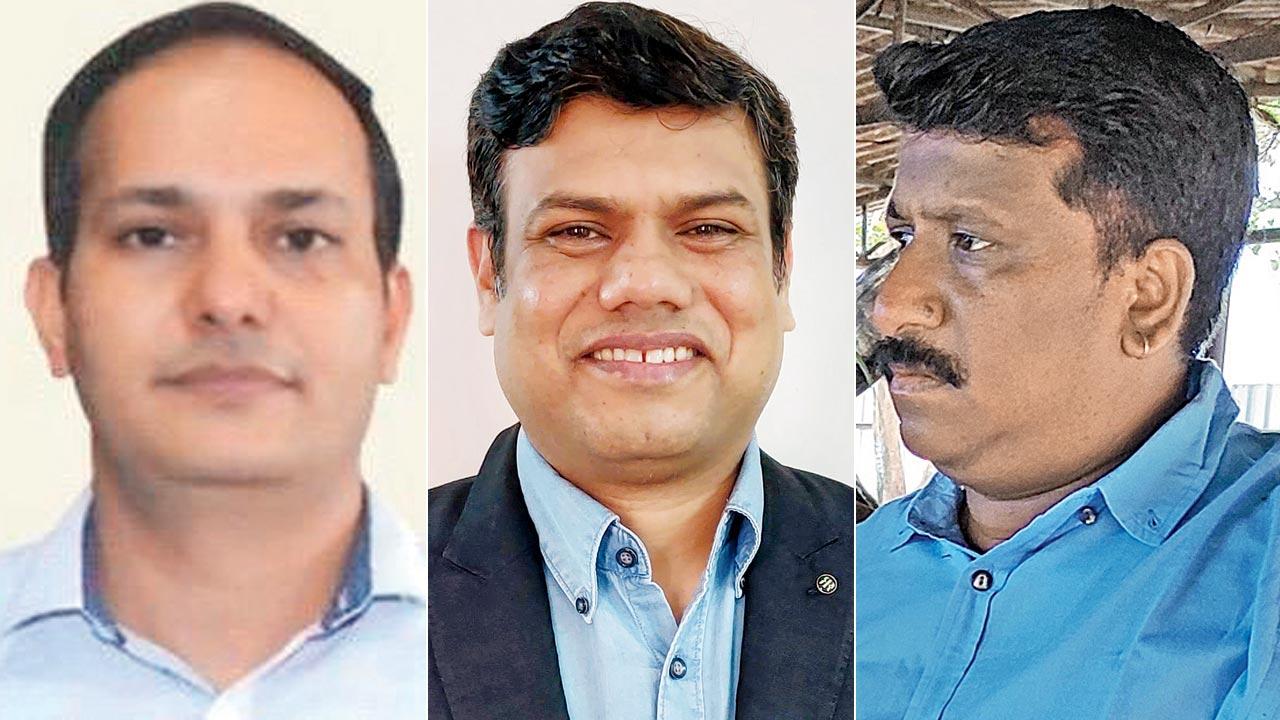 Sachindra Pratap Singh, Dr Uddhav Chaudhari and Shailesh Khotkar
Sachindra Pratap Singh, Dr Uddhav Chaudhari and Shailesh Khotkar
In Rajasthan, where the disease has spread to all 33 districts, the milk economy has already suffered a massive blow. According to a report in a national daily, the milk collection in the state witnessed a decline of over 21 per cent last month. A senior official of the Rajasthan Cooperative Dairy Federation (RCDF) had reported that the collection had reduced by five to six lakh litre per day—from 35 lakh litres to 27.54 litres.
Research by experts in countries that have been previously affected by LSD has pointed to similar concerns. A study published in the National Library of Medicine in 2020, stated that Ethiopia had seen a milk reduction by 5 litres per cow per day. Another study in Kenya indicated that milk production dropped by more than 50 per cent.
Dr Kokane suspects that Maharashtra’s milk supply has been hit already. This was confirmed by Mumbai-based Mahanand Dairy, a venture of the Maharashtra Rajya Sahakari Dudh Mahasangh Maryadit (MRSDMM). MRSDMM is an apex federation of district/taluka milk unions established in Maharashtra to procure milk from member milk unions at remunerative rates and distribute the same to consumers at reasonable rates.
Dairy and marketing manager at Mahanand Dairy, Kiran L Dhavale tells mid-day, “We do not have specific data to correlate milk production statistics with LSD, but overall there is definitely a drop of two to three per cent in milk production. If the disease continues, even though steps are being taken to contain it, there could be a major dip in milk production in the state in the future.” Dhavale warns that if this happens, milk prices could rise exponentially. “This will affect everyone in the state and country,” he adds.
Sachin Patil, spokesperson of Kolhapur Zilla Sahakari Dudh Utpadak Sangh Ltd, known for the dairy brand Gokul, however, said that it was too early to say whether the disease, would have ‘a direct impact on milk procurement’. “But if the situation continues like this in Maharashtra, like it has in Gujarat, we are all going to be paying the price for low milk production. Rates are bound to go up,” he says. The prices of sweets made from milk, which will be in demand during the upcoming festive season, are also expected to shoot up, dairy farmers say.
Last month, Gokul had raised the price of full cream milk by Rs 2 per litre in all centres, including Mumbai and Pune. In Mumbai, a litre currently costs Rs 66, up from Rs 64. This was the brand’s third hike in 15 months. As per an official statement, dairy giant Amul too decided to increase the retail price of fresh milk across the country by Rs 2 per litre, from August 17. Double toned milk, marketed as Amul Taaza, now costs Rs 44-46 per litre as against the earlier rate of Rs 42-44 per litre. Amul Gold, the full cream milk, is selling at Rs 62 per litre, as against the earlier Rs 60 per litre.
But IAS officer Sachindra Pratap Singh, commissioner of Maharashtra’s animal husbandry department and dairy development corporation, isn’t worried. He claims that at present there is no impact on production of milk in the state because the number of affected cattle is miniscule, when compared to the total cattle population of Maharashtra. “We have about 1.39 crore cattle in total, but only 19,160 of them are affected with LSD, so the focus group is really small for an impact to be felt. It is true that daily milk production reduces for a cow battling fever in the first 10 days of LSD, which is true for any other disease, but it goes back to normal production rate when the animal recovers. Since most of the milk production in Maharashtra is buffalo-based and that species has not seen any LSD cases, we have fortunately not been hit with the milk crisis directly like Rajasthan and Gujarat.”
Singh also believes that the state government’s quick response to LSD by overhauling the vaccination process and the learning from behavioural response and technical management of COVID-19 will go a long way in ‘controlling’ LSD. “The Indian government issued a notification stating the vaccination is to be done of all cows within five km radius of an affected animal. The state government, however, allowed us to go beyond the five km radius and vaccinate as many cows as possible, even those beyond the 1,066 epicentres of LSD identified in Maharashtra. We have already vaccinated 37 lakh cattle till now and aim to vaccinate over one crore by the end of September.” Another official at the state animal husbandry department tells mid-day that mass vaccination drives are being done to achieve ‘herd immunity’ like it was during COVID-19.
An aware farmer population in Maharashtra that responded promptly to calls for vaccination also saved the government from a massive hit. “We have the highest number of veterinary colleges in all of the states. Students [about 1,027] in the last year of these total six vet colleges and those pursuing their post graduation, have been roped in the vaccination drive. Former government vets have also been approached for expert advice. We have 95 teams of physicians and vets that have been spread across the state for LSD control. So even though there is a creation of more epicentres on a weekly basis, on a daily basis, we did see a peak in cases specifically on September 21. From then on, we have seen a daily downward trend,” Singh claims.
Meanwhile, cow shelters across Maharashtra have started taking precautions. Managing some 100 rescued cows at his centre, Nandini Gau Shala, in Kharghar, Navi Mumbai, Shailesh Khotkar says, “I got my cattle vaccinated at my own expense from a private distributor in Panvel, early in September. The animal husbandry department officials called me much later to inform me about the v
The animal husbandry department of the state is providing free vaccination services to farmers. Singh informs that the helpline number 1962 has been run by the department for farmers to call on and receive quick help. “As soon as we receive a call, the nearest veterinary centre of the district is dispatched to conduct vaccination on a priority basis. The cows cannot be brought to the centres, so we have to reach them.” The district animal husbandry hospitals are also facilitating treatment of affected cows, reported to them directly by farmers. Another official tells this writer that all Collectors have been “empowered to use funds up to the tune of R1 crore for procurement of vaccines, antibiotics and for anything else needed to control LSD”.
He also says that Maharashtra has decided to and is in the process of compensating farmers with Rs 30,000 for death of a milking cattle due to LSD, s in case of the death of a bullock and Rs 16,000 if an affected calf dies. But not everyone has been able to access the government’s help. Khotkar says he had to run from pillar to post for a vaccine and finally approached a private centre. He rues, “I had to do regular follow ups, before a private distributor in Panvel sold me the injection. In fact, they were only giving five vials at one go, because there was a vaccine shortage in early September.” He says he is taking double precaution by restricting human-animal interaction in the cow shelter.
When asked about the steps that farmers need to take to keep LSD in check, Dr Hirve says, “Early reporting is key to check the spread of the virus. If a farmer informs the government vet about infected cattle at the earliest, treatment can begin soon and the prognosis will be better.” He suggests that cattle should not be allowed to “stray in the forest or in areas with tall wild grass, which have a large population of vectors”. “Mosquito nets should be used around the shelter and mosquito repellents applied on the animal’s skin. Smoke from neem leaves and camphor should permeate the interiors of the shelter to repel vectors. The affected cattle should be immediately isolated on noticing symptoms.”
Back at Bhiwandi, farmers tell mid-day that while the government is trying to reach out to those affected with LSD, there is still something amiss. Gulvi has a bit of advice, “This should be a lesson for the state government to come up with a medical insurance policy for cattle. Not many farmers in the state are self-sufficient. During LSD, treatment is being provided free of cost, but there should be an insurance policy in place for any future disease that may strike us all.”
5-7 per cent
Fall in milk production in India since LSD outbreak, which amounts to approx. 60 lakh litres of milk daily, according to Dr Rajendra Kokane
Three
No. of price hikes per litre of milk in last 15 months by Gokul. In Mumbai, a litre currently costs R66, up from R64
Consumer Precaution
While experts say that LSD is not transferable through cow milk consumed by humans because the virus cannot survive without a host for more than 30 seconds, Dr Kokane suggests that everyone boils the milk thoroughly before consuming it for added protection.
 Subscribe today by clicking the link and stay updated with the latest news!" Click here!
Subscribe today by clicking the link and stay updated with the latest news!" Click here!







